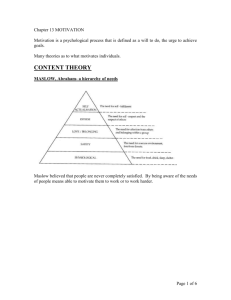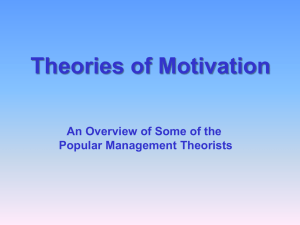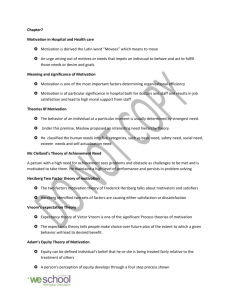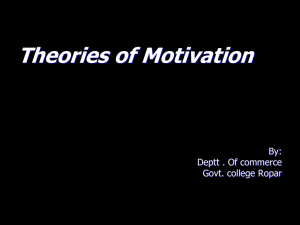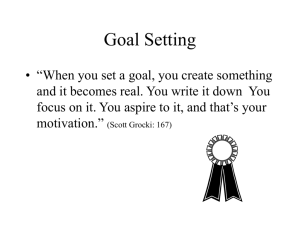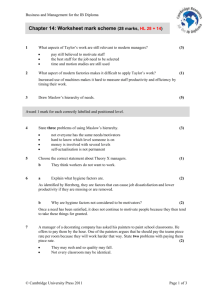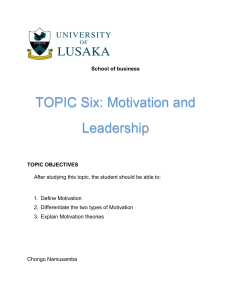click to
advertisement
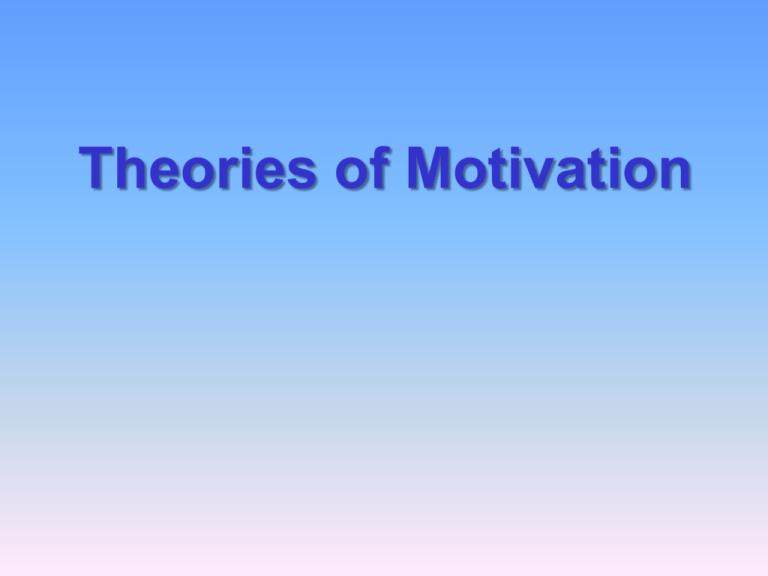
Theories of Motivation Abraham Maslow Maslow defined human needs as: Hierarchy of Needs Physiological: the need for food, drink, shelter, and relief from pain. Safety and security: the need for freedom from threat; the security from threatening events or surroundings. Belongingness, social, and love: the need for friendship, affiliation, interaction, and love. Esteem: the need for self-esteem and for respect from others. Self-actualization: the need to fulfill oneself by maximizing the use of abilities, skills, and potential Maslow’s Need Hierarchy • Maslow’s theory assumes that a person attempts to satisfy the more basic needs before directing behavior toward satisfying upper-level needs. • Lower-order needs must be satisfied before a higherorder need begins to control a person’s behavior. • A satisfied need ceases to motivate. Need Hierarchy Alderfer’s ERG Theory • • • ERG Theory • Clayton P Alderfer proposed a hierarchy involving three sets of needs: Existence: needs satisfied by such factors as food, air, water, pay, and working conditions. Relatedness: needs satisfied by meaningful social and interpersonal relationships. Growth: needs satisfied by an individual making creative or productive contributions. Tested by Thematic Apperception Test ERG Theory Relationships Among Frustration, Importance, and Satisfaction of Needs Frustration of growth needs Importance of growth needs Satisfaction of growth needs Frustration of relatedness needs Importance of relatedness needs Satisfaction of relatedness needs Frustration of existence needs Importance of existence needs Satisfaction of existence needs Frederick Herzberg (1923-2000) • His research emphasized job enrichment (depth) rather than job enlargement – Job context (hygiene factors) – needed to be optimal to prevent job dissatisfaction. These factors (according to Herzberg) did not motivate. – Job content (motivators) – factors that did lead to motivation – Money (according to Herzberg) could motivate if it was seen as a reward for accomplishment; but if money was given without regard for merit, then it was a hygiene factor. Frederick Herzberg Motivation and Hygiene Factors HYGIENE FACTORS ENVIRONMENT MOTIVATORS WHAT THEY DO Policies and Administration Achievement Supervision Recognition for Accomplishment Working Conditions Interpersonal Relations Money, Status, Security Challenging Work Increased Responsibility Growth and Development Herzberg’s Two-Factor Theory Extrinsic factors Intrinsic factors Factors within the job context: Factors within the job content: Pay Achievement Status Increased responsibility Working conditions Recognition Dissatisfiers Hygiene factors Satisfiers Motivators Frederick Herzberg Motivation and Hygiene Factors THE JOB SURROUNDINGS AND THE HYGIENE FACTORS SUPERVISION WORKING CONDITIONS RESPONSIBILITY BENEFITS INTERPERSONAL RELATIONSHIPS ACHIEVEMENT THE JOB ITSELF AND THE WORK ITSELF MOTIVATOR RECOGNITION FACTORS COMPANY POLICY AND ADMINISTRATION GROWTH ADVANCEMENT SECURITY STATUS SALARY Douglas McGregor (1906-1964) Douglas McGregor • Taught psychology at MIT. • At Antioch College, McGregor found that his classroom teaching of human relations did not always work in practice. • From these experiences, his ideas evolve and lead him to recognize the influence of assumptions we make about people and our managerial style. Theory X • • • Management is responsible for organizing the elements of productive enterprise – money, materials, equipment, people – in the interest of economic ends. With respect to people, this is a process of directing their efforts, motivating them, controlling their actions, modifying their behavior to fit the needs of the organization. Without this active intervention by management, people would be passive – even resistant – to organizational needs. They must, therefore, be persuaded, rewarded, punished, controlled – their activities must be directed. This is management’s task -- in managing subordinate managers or workers. We often sum it up by saying that management consists of getting things done through other people. Theory X • Behind this conventional theory there are several additional beliefs – less explicit, but widespread: – – – – – The average man is by nature indolent – he works as little as possible. He lacks ambition, dislikes responsibility, prefers to be led. He is inherently self-centered, indifferent to organizational needs. He is by nature resistant to change. He is gullible, not very bright. Theory Y • • • • Management is responsible for organizing the elements of productive enterprise – money, materials, equipment, people – in the interest of economic ends. People are not by nature passive or resistant to organizational needs. They have become so as a result of experience in organizations. The motivation, the potential for development, the capacity for assuming responsibility, the readiness to direct behavior toward organizational goals are all present in people. Management does not put them there. It is a responsibility of management to make it possible for people to recognize and develop these human characteristics for themselves. The essential task of management is to arrange organizational conditions and methods of operation so that people can achieve their own goals best by directing their own efforts toward organizational objectives. Theory X • • • • • Work is inherently distasteful to most people. Most people are not ambitious, have little desire for responsibility, and prefer to be directed. Most people have little capacity for creativity in solving organizational problems. Motivation occurs only at the physiological and safety levels. Most people must be closely controlled and often coerced to achieve organizational objectives. Theory Y • • • • • Work is as natural as play, if the conditions are favorable. Self-control is often indispensable in achieving organizational goals. The capacity for creativity in solving organizational problems is widely distributed in the population. Motivation occurs at the social, esteem, and selfactualization levels, as well as physiological and security levels. People can be self-directed and creative at work if properly motivated. THEORY Z • William Ouchi proposed Theory Z • Comparative study of American and Japanese management Practices. • Features: • Trust • OrganisationEmployee Relationship • Employee Participation • Structureless Organisation • Holistic Concern for Employees David McClelland Proposed Theory of Needs: nAch nPow nAff Need for Achievement (nAch) – drive to excel, to achieve in relation to a set of standards Need for Affiliation (nAff) – the desire for friendly and close interpersonal relationships Need for Power (nPow) – need to make others behave in a way in which they would not have behaved otherwise (to have power over them) McClelland’s Learned Needs Theory Achievement (n Ach) Affiliation (n Aff) Power (n Pow) A Comparison of the Content Theories Maslow (need hierarchy) Self-actualization Higher order needs Esteem Belongingness, social, and love Safety and security Herzberg (two-factor theory) The work itself •Responsibility •Advancement Motivators •Growth Alderfer Need for achievement Growth Need for power Achievement Recognition Quality of interpersonal relations among peers, with supervisors, with subordinates Relatedness Hygiene conditions Job security Basic needs Physiological Working conditions Salary McClelland Existence Need for affiliation Motivation: Expectancy Theory Victor Vroom • The expectancy theory of Victor Vroom helps explain the choosing process among individuals in terms of the value (valence) of the reward and the expectancy of receiving the reward. Victor Vroom VROOM’S EXPECTANCY THEORY • MOTIVATION= VALENCE*EXPECTANCY*INSTRUMENT ALITY • EVALUATION OF THE EXPECTANCY MODEL:• PLUS POINTS • NEGATIVE POINTS PORTER & LAWLER MODEL OF MOTIVATION • Lyman Porter and Edward Lawler extended Vroom’s work with their model of expectancy. ELEMENTS OF THIS MODEL • EFFORT • VALUE OF REWARD • PERCEIVED EFFORT REWARD PROBABILITY • PERFORMANCE • REWARDS • SATISFACTION Expectancy Theory (Lyman W. Porter – Edward E. Lawler III) Revised Diagram of the Theoretical Model 1 Abilities And Traits Value of Reward Perceived 8 Equitable Rewards 4 7A Intrinsic Rewards 3 9 6 Performance (Accomplishments) Effort Satisfaction 7B Extrinsic Rewards Perceived 2 Effect-Reward Probability 5 Role Perceptions SOURCE: Managerial Attitudes and Performance, 1968, Richard D. Irwin Inc. Equity Theory • Equity theory is not a new one but focuses on how individuals perceive their reward or pay compared to what others are receiving. • Issues of social justice and distributive justice are involved in the theories of Stacy Adams and Elliot Jaques. Elliot Jacques Process Theories of Motivation: Equity Theory • Employees compare their efforts and rewards with those of others in similar work situations. • Individuals, who work in exchange for rewards from the organization, are motivated by a desire to be equitably treated at work. • Equity exists when employees perceive that the ratios of their inputs (efforts) to their outcomes (rewards) are equivalent to the ratios of other similar employees. • Inequity exists when these ratios are not equivalent. The Equity Theory of Motivation A person (P) with certain inputs (I) and receiving certain outcomes (O) Compares his/her input/outcome ratio to reference person’s (RP) inputs (I) and outcomes (O) and perceives OP IP ORP = IRP or equity OP IP < ORP IRP inequity or OP IP IP: Inputs of the person OP: Outcomes of the person IRP: Inputs of reference person ORP: Outcomes of reference person > ORP IRP inequity GOAL SETTING THEORY Given by Edwin Locke Hard task- high level of effort Feedback Self generated feedback Participation in goal-setting Goal performance relationshipGoal commitment, self-efficacy, task characteristics and national culture

